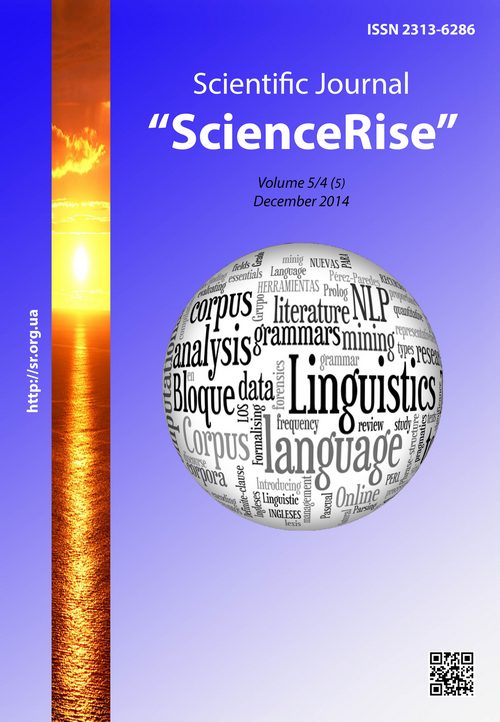Влияние современных технологий доения и психротрофных микроорганизмов на содержание свободных жирных кислот в молоке
DOI:
https://doi.org/10.15587/2313-8416.2014.32252Ключевые слова:
свободные жирные кислоты, доение робототехникой, холодильное хранение сырого молока, психротрофы, Pseudomonas sppАннотация
Установлено, что доение коров робототехникой в большей степени влияет на образование свободных жирных кислот (СЖК) в молоке, чем доение на АСД «Карусель». Среди всех исследуемых нами СЖК, наибольшую концентрацию в молоке составляли пальмитиновая, олеиновая и стеариновая жирные кислоты. Pseudomonas spp в молоке при холодильном хранении выделяют липазы, способствующие образованию СЖК. Добавление раствора Н2О2 к сырому молоку, приостанавливает образование бактериальных липаз.
Библиографические ссылки
Ipema, A. H., Schuiling, E. (1992). Free fatty acids; influence of milking frequency. in Proceedings of the Symposium Prospects for Automatic Milking EAAP Publ. 65, Wageningen, the Netherlands, 491–496.
Klungel, G. H., Slaghuis, B. A., Hogeveen, H. (2000). The effect of the introduction of automatic milking on milk quality. Journal of Dairy Science, 83 (9), 1998–2003. doi: 10.3168/jds.s0022-0302(00)75077-6
Cartier, P., Chilliard, Y. (1990). Spontaneous lipolysis in bovine milk: combined effects of nine characteristics in native milk. Journal of Dairy Science, 73 (5), 1178–1186. doi: 10.3168/jds.s0022-0302(90)78780-2
Rasmussen, M. D., Bjerring, M., Justesen, P., Jepsen, L. (2002). Milk quality on Danish farms with automatic milking systems. Journal of Dairy Science, 85 (11), 2869–2878. doi: 10.3168/jds.s0022-0302(02)74374-9
Escobar, G. J., Bradley, R. L. (1990). Effect of mechanical treatment on the free fatty acid content of raw milk. Journal of Dairy Science, 73 (8), 2054–2060. doi: 10.3168/jds.s0022-0302(90)78884-4
Antonelli, M. L., Curini, R., Scricciolo, D., Vinci, G. (2002). Determination of free fatty acids and lipase activity in milk: quality and storage markers. Talanta, 58 (3), 561–568. doi: 10.1016/s0039-9140(02)00324-7
Mikulova, M. (2011). Content of free fatty acids lipolytic bacteria and somatic cells in relation to milking technology. Journal of Agrobiology, 28 (1), 49–54. doi: 10.2478/v10146-011-0005-8
Cempirkova, R., Mikulova, M. (2009). Incidence of psychrotrophic lipolytic bacteria in cow’s raw milk. Czech J. Anim. Sci., 54 (2), 65–73.
Fleming, M. G. (1980). Mechanical factors associated with milk lipolysis in bovine milk. In IDF bulletin 118 Flavour impairment of milk and milk products due to lipolysis, 41–52.
De Koning, C. J. A. M., Slaghuis, B., van der Vorst, Y. (2004). Milk Quality on Farms with an Automatic Milking System. Proceedings of the international symposium Automatic Milking, a better understanding, Wageningen Academic Publishers, Wageningen, the Netherlands, 311–320.
Wiking, L., Bjrck, L., Nielsen, J. H. (2004). Impact of size distribution of milk fat globules on milk quality affected by pumping. Automatic Milking- a better understanding. Wageningen Academic Publishers, 348–356
Foltys, V., Kirchnerova, K. (2006). Mesophilic and psychrotrophic aerobe sporulating microorganisms in raw cow’s milk. Central European Journal of Biology, 1 (4), 545–560. doi: 10.2478/s11535-006-0037-z
Pešek, M., Samková, E., Špička, J. (2006). Fatty acids and composition of their important groups in milk fat of Czech Pied cattle. Czech J. Anim. Sci., 51, 181–188
Berentsen, P. B. M., Engel, B., De Koning, C. J. A. M., Oude Lansink, A. G. J.,M. (2010). Increasing the Revenues from Automatic Milking by Using Individual Variation in Milking Characteristics. Economical sensitivity of four main parameters defining the room for investment of AM-systems on dairy farms, Robotic Milking, Proceedings of the international symposium held in Lelystad, 201–211.
Bijl, R., Kooistra, S. R., Hogeveen, H. (2007). The Profitability of Automatic Milking on Dutch Dairy Farms. Journal of Dairy Science, 90 (1), 239–248. doi: 10.3168/jds.s0022-0302(07)72625-5
De Koning, C. J. A. M., Rodenburg, J. (2004). Automatic Milking: State of the Art in Europe and North America. Automatic milking – A better understanding, Wageningen Academic Publishers, Wageningen, the Netherlands, 27-40.
Hink, P. (2000). Effects of husbandry systems on the efficiency and optimisation of robotic milking performance and management. International Symposium on Robotic Milking, Lelystad, The Netherlands, 167–176.
Vorst, Y., Koning, K. (2002). Automatic milking systems and milk quality in three European countries. Proc. 1rst North American Conference on Robotic Milking, Toronto, Canada, V1-V12.
Vegricht, J. (2002). Study of Using Automati c Milking Systems on Large Dairy Farms. Research In Agricultural Engineering, 48 (1), 1–6.
Barth K., Fischer R., Worstorff H. (2000). Evaluation of variation in conductivity during milking to detect sub- clinical mastitis in cows milked by robotic systems. Proc. International Symposium on Robotic Milking, Lelystad, The Netherlands, 89-96.
Klungel, G. H., Slaghuis, B. A., Hogeveen, H. (2000). The effect of the introduction of automatic milking systems on milk quality. Journal of Dairy Science, 83 (9), 1998–2003. doi: 10.3168/jds.s0022-0302(00)75077-6
Hantis-Zacharov, E., Halpern, M. (2007). Culturable psychrotrophic bacteria communities in raw milk and their proteolytic and lipolytic traits. Applied and Environmental Microbiology, 73 (22), 7162–7168. doi: 10.1128/aem.00866-07
Загрузки
Опубликован
Выпуск
Раздел
Лицензия
Copyright (c) 2014 Александра Николаевна Бергилевич, Андрей Николаевич Марченко, Олег Александрович Бергилевич

Это произведение доступно по лицензии Creative Commons «Attribution» («Атрибуция») 4.0 Всемирная.
Наше издание использует положения об авторских правах Creative Commons CC BY для журналов открытого доступа.
Авторы, которые публикуются в этом журнале, соглашаются со следующими условиями:
1. Авторы оставляют за собой право на авторство своей работы и передают журналу право первой публикации этой работы на условиях лицензии Creative Commons CC BY, которая позволяет другим лицам свободно распространять опубликованную работу с обязательной ссылкой на авторов оригинальной работы и первую публикацию работы в этом журнале.
2. Авторы имеют право заключать самостоятельные дополнительные соглашения, которые касаются неэксклюзивного распространения работы в том виде, в котором она была опубликована этим журналом (например, размещать работу в электронном хранилище учреждения или публиковать в составе монографии), при условии сохранения ссылки на первую публикацию работы в этом журнале .

